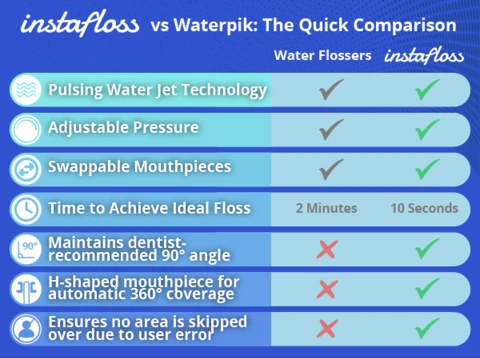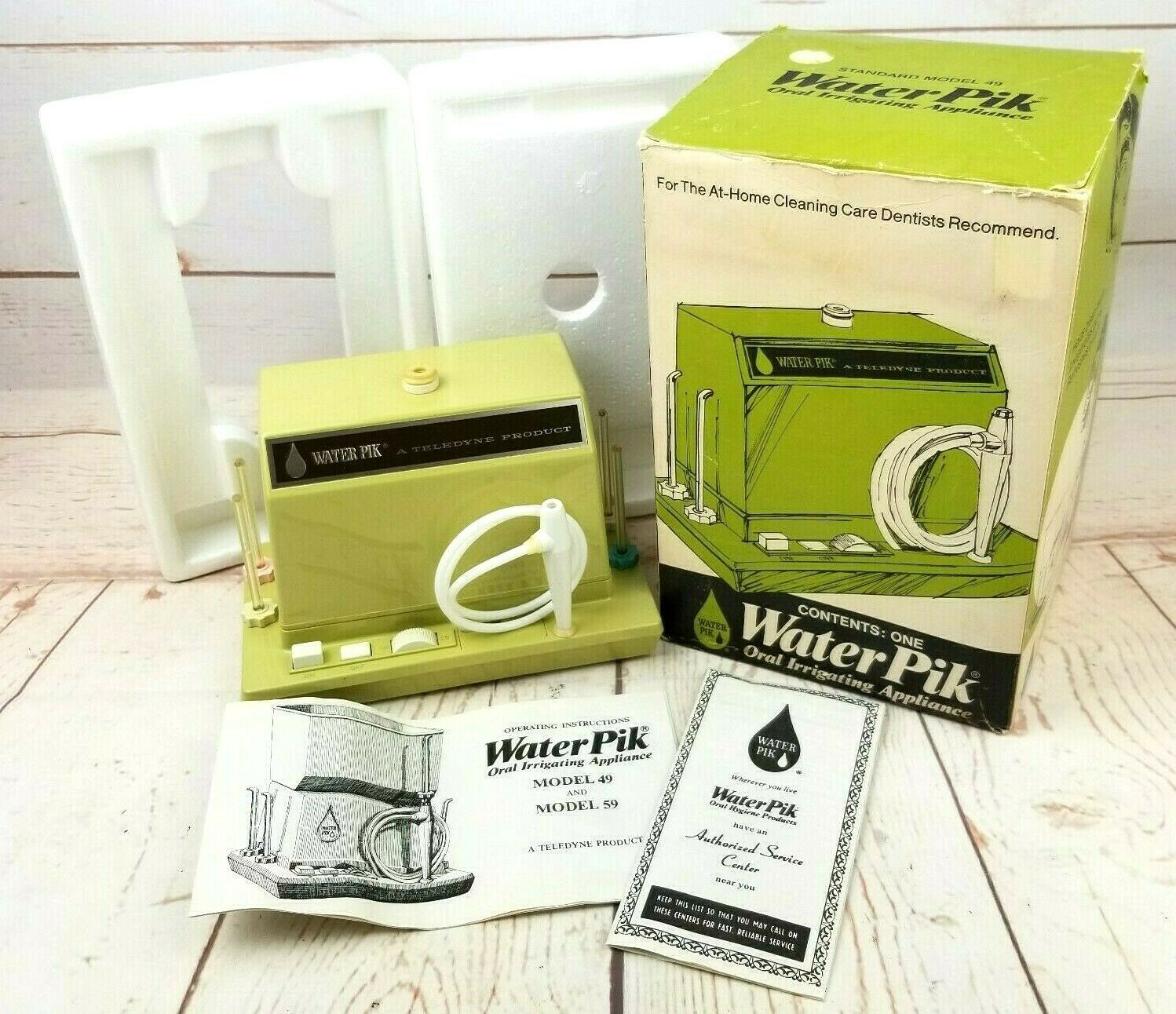Edited on October 2025 to include information on why the Instafloss mouthpiece is not compatible with Waterpik or similar single jet water flossers.
Instafloss is a hot new take on the water flossing concept, but if you’ve been aware of water flossers (also known as oral irrigators) for some time, you’ll know Waterpik has been around for some time. If you’re looking to decide on your next water flosser and you’ve narrowed the choices to Waterpik vs Instafloss, here’s everything you need to know.
Instafloss: The Next Step in Water Flossing’s Evolution
Instafloss isn’t reinventing the wheel. It’s still based upon the scientifically-proven core concept of using a pulsing water jet to gently, but effectively, dislodge debris, clear plaque, and massage the gums. The main difference between the two products is Instafloss’ inclusion of multiple water jets and a H-shaped mouthpiece.

Here you can see the H-shape at work, effectively and quickly cleaning both the top and bottom rows of teeth as well as the front and back of each row. This saves on time, reducing flossing from over 2 minutes with Waterpik to under 10 seconds with Instafloss.

And in the above gif, you can see how the multiple water jets are always maintained at 90° and overlap to floss each area of the tooth in record time. This reduces user error, eliminating the need to carefully aim a single jet and trace the gumline on both sides while manually maintaining a 90° angle. Instead, the jets are aimed for you and assure that no area is missed or skipped over.
These small but important tweaks enable Instafloss to work faster and more accurately than the single jet Waterpik. Instafloss also requires less dexterity to complete a proper floss, making it a useful tool for children, the elderly, those with disabilities, or anyone who wants to be sure they’re flossing correctly every time.
Waterpik: A Revolutionary Invention, With Room for Improvement
Waterpik was first created in 1962 and has since grown into a household name brand. However, while they’ve grown to be an increasingly common sight on bathroom sinks, they haven’t changed much since their original introduction
Here’s a Waterpik from 1969 complete with product packaging:

And here’s a Waterpik from 2021:

At first glance the housing looks wildly different, but if you look closer you’ll start to notice that much of the product remains unchanged. The hose looks to be the same exact style, but longer, there’s adjustable water pressure, and water flows from a single jet. The only major difference appears to be that the handle appears more ergonomic and includes an on/off switch on the newest model.
This isn’t necessarily a bad thing, the Waterpik is a solid improvement over string floss in terms of comfort and effectiveness. However, many users complain that water flossing is hard to do correctly and takes too much time, leaving much room for improvement. Instafloss builds upon Waterpik’s success, bringing innovation that makes flossing quicker, easier, and reduces human-error
Instafloss vs Waterpik: The Quick Comparison

Other water flossers have only 1 jet that you must manually use, which means they take a long time to floss and are difficult to aim correctly (90° to the gumline, including the backs of your teeth!). In contrast, Instafloss uses multiple jets to give a perfect water floss in only ten seconds.

As seen above, the jets are always aimed 90° to the gumline, floss 360° around every tooth, and they never miss a single spot. On top of that, the multiple jets feature overlapping coverage to ensure your floss is as effective as possible.
Why Can't I Use an Instafloss Mouthpiece on Waterpik?
We've been getting a lot of questions asking whether Instafloss mouthpieces could be used on waterpik or similar single jet oral irrigators. The answer, unfortunately is no.
It's not just because the attachment methods for the mouthpieces differ. It has to do with the strength of the motor inside of single jet water flossers relative to the strength of the motor inside Instafloss.
In order to achieve the necessary water pressures for an effective clean, Instafloss uses a much more powerful motor than other single jet water flossers. This is one of the big reasons our unit is more expensive, as we have to pay for a top of the line motor and pump assembly to ensure you get an effective clean.
This stronger pump, means that if you were to put a single jet attachment on Instafloss, the water pressures would be too high and could cause pain or damage to your gums. On the other hand, if you were to put a multi-jet, Instafloss mouthpiece on a Waterpik, then you'd end up with water pressures that are too low to effectively clean your gums.
Conclusion
Instafloss brings innovation to water flossing where other designs have remained largely unchanged since the 60s. It does so with no downsides other than price, and even then, the higher priced Waterpiks are similarly priced to Instafloss. To recap, the benefits of Instafloss when compared to Waterpik are:
- Speed: Instafloss takes only 10 seconds to do a complete floss vs Waterpik’s 2 minutes
- Accuracy: Waterpik relies on you to trace your gumline on both sides while Instafloss aims for you. This results in an accurate floss every time
- Convenience: Instafloss’ H-mouthpiece automatically pivots as you sweep around your mouth, making Instafloss the most convenient option by far.



1 comment
Can Instafloss be used on braces
———
Instafloss replied:
Hello Linda,
Yes it can! Water flossing is recommended for braces in many cases since it can prove to be much easier than string. Additionally, water flossing has been shown to be more effective than string in a number of ways, whether you have braces or not :)
With Smiles, The Instafloss Team